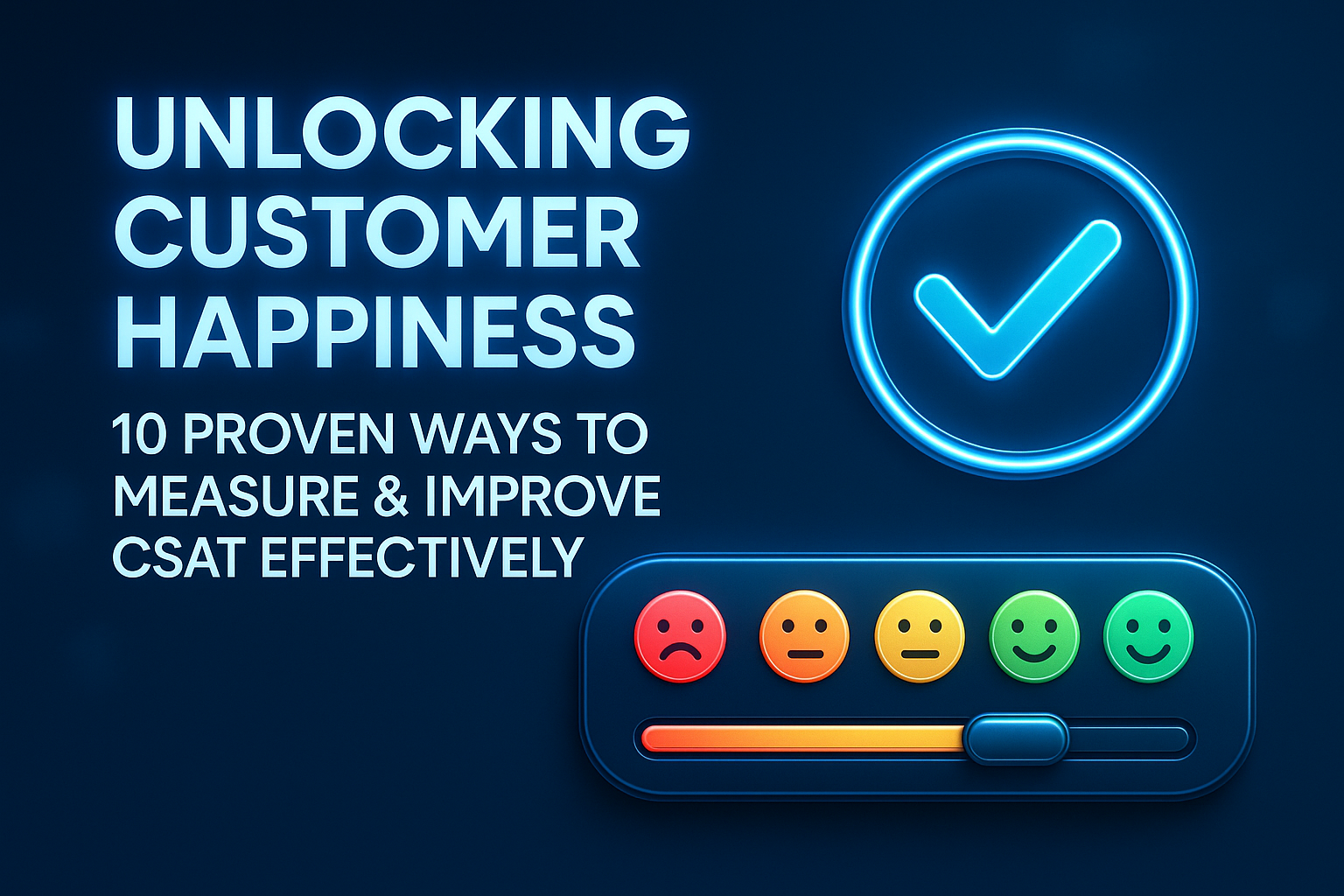
What is CSAT?
Customer Satisfaction Score, or CSAT, is a critical metric used to measure how satisfied customers are with your products, services, or support interactions. It reflects the immediate perception of a specific experience.
CSAT is usually measured via a simple question:
“How satisfied were you with your experience?”
Customers typically respond on a 1–5 scale, with 1 being “very unsatisfied” and 5 being “very satisfied”.
Why CSAT Matters in Modern Customer Experience
In today’s hyper-competitive landscape, your product isn’t your only differentiator—experience is everything. CSAT helps you understand if you’re meeting customer expectations, delivering delight, or falling short.
High CSAT scores are linked with:
-
Increased customer loyalty
-
Higher lifetime value (LTV)
-
Better word-of-mouth marketing
-
Fewer support escalations
Key Benefits of Tracking CSAT
-
Actionable Feedback: You get clear insights into what’s working or not.
-
Improved Customer Retention: Satisfied customers stick around.
-
Early Problem Detection: A drop in CSAT could signal product or service issues.
-
Employee Performance Measurement: Useful for coaching and performance reviews.
-
Revenue Growth: Happy customers spend more and churn less.
The Difference Between CSAT, NPS, and CES
It’s easy to confuse CSAT with other metrics like NPS (Net Promoter Score) and CES (Customer Effort Score). But each serves a unique purpose.
| CSAT | NPS |
|---|---|
| Measures satisfaction post-interaction | Measures overall brand loyalty |
| Immediate, transactional | Strategic, long-term |
| Asked on a 1–5 scale | Asked on a 0–10 scale |
| CSAT | CES |
|---|---|
| Subjective satisfaction rating | Measures ease of resolution |
| Useful for emotional insights | Ideal for support teams |
| Often tied to happiness | Focuses on friction points |
How to Calculate CSAT Score Accurately
The formula is simple:
CSAT = (Number of Satisfied Customers ÷ Total Responses) × 100
If 80 out of 100 customers respond with a 4 or 5, your CSAT is:
(80/100) × 100 = 80%
CSAT Rating Scale Explained
CSAT surveys usually use:
-
1 = Very Dissatisfied
-
2 = Dissatisfied
-
3 = Neutral
-
4 = Satisfied
-
5 = Very Satisfied
Some brands use emojis or smiley faces to make surveys more user-friendly.
Best Channels to Collect CSAT Feedback
Send follow-up emails after customer interactions. These are especially effective after support calls or ticket closures.
Perfect for SaaS platforms or mobile apps. Show the survey after a task completion or feature use.
Use post-call IVR surveys for immediate feedback in contact centers.
10 Powerful Ways to Improve CSAT Score
Always respond to negative feedback. Apologize, resolve, and follow up. Customers love feeling heard.
Invest in soft skills, empathy, and product knowledge. Happy agents = happy customers.
Tools like ODIO help analyze calls and chats for sentiment, intent, and CSAT trends automatically.
Use names, previous interactions, and preferences to deliver tailored support.
Track response times, first-call resolution, and tone. Coaching based on these metrics drives improvement.
6. Offer Omnichannel Support
Let customers reach you on chat, email, phone, or social—and maintain context across channels.
Remove friction. Simplify checkout, account creation, or ticket submission.
Under-promise and over-deliver. Be transparent about what customers can expect and when.
Notify customers about delays or known issues before they complain.
Use bots for FAQs, but offer a smooth handoff to humans when needed.
Common Mistakes That Hurt CSAT
-
Ignoring feedback
-
Offering generic responses
-
Delayed responses
-
Not acting on trends
-
Poor self-service tools
Avoid these pitfalls to keep your CSAT trending upward.
How Often Should You Measure CSAT?
There’s no one-size-fits-all. But here are common touchpoints:
-
After support interactions
-
Post-purchase or delivery
-
After onboarding or product use
-
Monthly or quarterly check-ins
The key? Be consistent.
Tools to Help Track and Improve CSAT
-
ODIO – Real-time contact center AI analytics
-
Qualtrics – Enterprise feedback management
-
SurveyMonkey – Simple surveys
-
Zendesk – Built-in CSAT measurement
-
HubSpot – CSAT integrated with CRM
Real-World CSAT Success Stories
Zappos: Known for legendary support, their CSAT consistently tops 90%.
Amazon: Uses post-delivery surveys and personalized feedback requests to stay ahead.
ODIO: Brands using ODIO’s voicebot + human support strategy saw a 23% CSAT improvement in 3 months.
FAQs About CSAT
Q1. Is CSAT more important than NPS?
A1. They serve different purposes. CSAT helps with immediate feedback; NPS gauges long-term loyalty. Ideally, use both.
Q2. What is a good CSAT score?
A2. Anything above 75% is generally considered strong. World-class brands often hit 85%+.
Q3. Can CSAT be manipulated?
A3. Yes, asking only happy customers or biased questions skews results. Stay transparent and consistent.
Q4. Should I incentivize customers to fill CSAT surveys?
A4. It can boost response rates, but don’t overdo it. A small token or thank-you is fine.
Q5. How do I handle low CSAT scores?
A5. Reach out to dissatisfied users. Understand the root cause and offer resolution. Document the feedback for internal improvements.
Q6. How long should a CSAT survey be?
A6. Keep it short—1–3 questions max. The faster it is, the more likely people will complete it.
Conclusion: Making CSAT Central to Your Customer Strategy
CSAT is more than a score—it’s your customer heartbeat.
By regularly measuring it, acting on feedback, and continuously improving service, you create loyal fans—not just buyers. Whether you’re in SaaS, eCommerce, or a service industry, CSAT can be your secret weapon to scale sustainably.
Invest in tools, train your team, and most importantly—listen to your customers.

